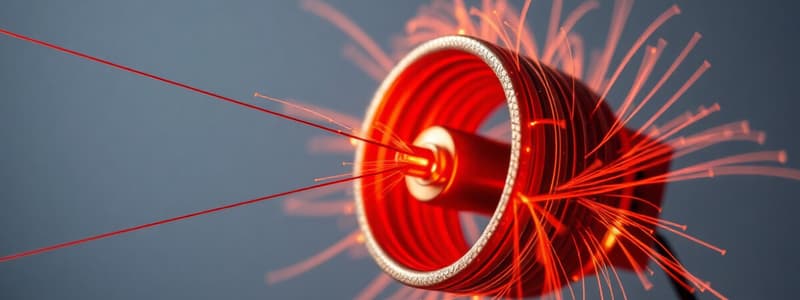Podcast
Questions and Answers
If the magnetic flux through a loop of wire is held constant, what can be said about the induced electromotive force (EMF)?
If the magnetic flux through a loop of wire is held constant, what can be said about the induced electromotive force (EMF)?
- The induced EMF is zero. (correct)
- The induced EMF increases linearly with time.
- The induced EMF decreases exponentially with time.
- The induced EMF is constant and non-zero.
A circular loop of wire with a radius of 0.05 m is placed in a uniform magnetic field of 0.8 T. The magnetic field is perpendicular to the plane of the loop. Determine the magnetic flux through the loop.
A circular loop of wire with a radius of 0.05 m is placed in a uniform magnetic field of 0.8 T. The magnetic field is perpendicular to the plane of the loop. Determine the magnetic flux through the loop.
- $0.0628 \text{ Wb}$
- $0.00628 \text{ Wb}$ (correct)
- $0.00126 \text{ Wb}$
- $0.628 \text{ Wb}$
A square loop of wire with sides of length 0.2 m is placed in a magnetic field of 0.5 T. The plane of the loop is oriented at a 30-degree angle to the magnetic field. What is the magnetic flux through the loop?
A square loop of wire with sides of length 0.2 m is placed in a magnetic field of 0.5 T. The plane of the loop is oriented at a 30-degree angle to the magnetic field. What is the magnetic flux through the loop?
- $0.010 \text{ Wb}$
- $0.035 \text{ Wb}$
- $0.020 \text{ Wb}$
- $0.017 \text{ Wb}$ (correct)
A coil with 200 turns has a cross-sectional area of $0.002 \text{ m}^2$. It is placed in a magnetic field that changes from 0.2 T to 0.6 T in 0.5 seconds. The field is directed perpendicular to the coil's surface. Calculate the average induced EMF in the coil.
A coil with 200 turns has a cross-sectional area of $0.002 \text{ m}^2$. It is placed in a magnetic field that changes from 0.2 T to 0.6 T in 0.5 seconds. The field is directed perpendicular to the coil's surface. Calculate the average induced EMF in the coil.
Consider a scenario where a bar magnet is moved toward a coil of wire. According to Lenz's Law, what is the direction of the induced current's magnetic field?
Consider a scenario where a bar magnet is moved toward a coil of wire. According to Lenz's Law, what is the direction of the induced current's magnetic field?
A conducting loop is placed in a uniform magnetic field, with the plane of the loop perpendicular to the field. If the loop is then rotated by 90 degrees in 0.2 seconds, what is the average induced EMF in the loop, given the magnetic field strength is 2 T and the area of the loop is $0.05 \text{ m}^2$?
A conducting loop is placed in a uniform magnetic field, with the plane of the loop perpendicular to the field. If the loop is then rotated by 90 degrees in 0.2 seconds, what is the average induced EMF in the loop, given the magnetic field strength is 2 T and the area of the loop is $0.05 \text{ m}^2$?
A flexible loop of wire with an area of $0.12 \text{ m}^2$ is placed in a uniform magnetic field of 0.6 T, with the plane of the loop perpendicular to the field. If the loop's area is steadily reduced to zero in 0.5 seconds, what is the magnitude of the average induced EMF in the loop during this time?
A flexible loop of wire with an area of $0.12 \text{ m}^2$ is placed in a uniform magnetic field of 0.6 T, with the plane of the loop perpendicular to the field. If the loop's area is steadily reduced to zero in 0.5 seconds, what is the magnitude of the average induced EMF in the loop during this time?
A coil of wire with 50 turns is in a magnetic field. The magnetic flux through the coil changes from $0.02 \text{ Wb}$ to $0.06 \text{ Wb}$ in 2 seconds. What is the magnitude of the induced EMF in the coil?
A coil of wire with 50 turns is in a magnetic field. The magnetic flux through the coil changes from $0.02 \text{ Wb}$ to $0.06 \text{ Wb}$ in 2 seconds. What is the magnitude of the induced EMF in the coil?
A wire loop is moved from a region of zero magnetic field into a region with a uniform magnetic field, with the loop's plane perpendicular to the field. According to Lenz's Law, what is the direction of the induced current in the loop?
A wire loop is moved from a region of zero magnetic field into a region with a uniform magnetic field, with the loop's plane perpendicular to the field. According to Lenz's Law, what is the direction of the induced current in the loop?
A circular coil with a radius of 0.10 m and 30 turns is rotated in a uniform magnetic field of 0.4 T from a position where the coil's plane is perpendicular to the field to a position where it is parallel to the field in 0.5 seconds. What is the average EMF induced in the coil?
A circular coil with a radius of 0.10 m and 30 turns is rotated in a uniform magnetic field of 0.4 T from a position where the coil's plane is perpendicular to the field to a position where it is parallel to the field in 0.5 seconds. What is the average EMF induced in the coil?
A magnetic field of 1.5 T is applied perpendicularly to a circular loop with a radius of 5 cm. If the magnetic field is uniformly reduced to 0 T in 0.1 seconds, what is the magnitude of the induced EMF in the loop?
A magnetic field of 1.5 T is applied perpendicularly to a circular loop with a radius of 5 cm. If the magnetic field is uniformly reduced to 0 T in 0.1 seconds, what is the magnitude of the induced EMF in the loop?
A square loop of wire is placed near a straight wire carrying a decreasing current. What is the direction of the induced current in the square loop?
A square loop of wire is placed near a straight wire carrying a decreasing current. What is the direction of the induced current in the square loop?
A circular loop of wire with a radius of 8 cm is in a uniform magnetic field of 0.5 T. The loop is rapidly compressed to a radius of 2 cm in 0.2 seconds. Find the average induced EMF in the loop during this compression.
A circular loop of wire with a radius of 8 cm is in a uniform magnetic field of 0.5 T. The loop is rapidly compressed to a radius of 2 cm in 0.2 seconds. Find the average induced EMF in the loop during this compression.
If a coil is oriented such that the magnetic flux through it is maximized, how is the coil positioned with respect to the magnetic field lines?
If a coil is oriented such that the magnetic flux through it is maximized, how is the coil positioned with respect to the magnetic field lines?
A coil with 150 turns and a cross-sectional area of $0.04 \text{ m}^2$ is placed in a magnetic field that is initially zero and increases to 0.8 T in 0.4 seconds. The magnetic field is perpendicular to the coil's surface. What is the induced EMF in the coil?
A coil with 150 turns and a cross-sectional area of $0.04 \text{ m}^2$ is placed in a magnetic field that is initially zero and increases to 0.8 T in 0.4 seconds. The magnetic field is perpendicular to the coil's surface. What is the induced EMF in the coil?
A loop of wire is pulled away from a permanent magnet. According to Lenz's Law, what is the direction of the induced current's magnetic field with respect to the magnet?
A loop of wire is pulled away from a permanent magnet. According to Lenz's Law, what is the direction of the induced current's magnetic field with respect to the magnet?
A rectangular loop of wire with dimensions 10 cm x 20 cm is placed in a magnetic field of 0.8 T. The plane of the loop makes an angle of 60 degrees with the magnetic field. Calculate the magnetic flux through the loop.
A rectangular loop of wire with dimensions 10 cm x 20 cm is placed in a magnetic field of 0.8 T. The plane of the loop makes an angle of 60 degrees with the magnetic field. Calculate the magnetic flux through the loop.
A circular loop of wire with a radius of 12 cm lies in a magnetic field of 0.6 T. The magnetic field is reduced to zero in 0.5 seconds. Determine the average induced EMF in the loop.
A circular loop of wire with a radius of 12 cm lies in a magnetic field of 0.6 T. The magnetic field is reduced to zero in 0.5 seconds. Determine the average induced EMF in the loop.
A conducting rod is moved perpendicularly across a uniform magnetic field. According to Faraday's Law, what factor would NOT affect the magnitude of the induced EMF in the rod?
A conducting rod is moved perpendicularly across a uniform magnetic field. According to Faraday's Law, what factor would NOT affect the magnitude of the induced EMF in the rod?
A square coil with an area of $0.05 \text{ m}^2$ and 20 turns is placed in a magnetic field of 0.2 T. The angle between the coil's normal and the magnetic field is 30 degrees. Find the magnetic flux through the coil.
A square coil with an area of $0.05 \text{ m}^2$ and 20 turns is placed in a magnetic field of 0.2 T. The angle between the coil's normal and the magnetic field is 30 degrees. Find the magnetic flux through the coil.
A coil of wire is connected to a galvanometer. What would cause a deflection in the galvanometer's needle?
A coil of wire is connected to a galvanometer. What would cause a deflection in the galvanometer's needle?
A circular loop of wire with a radius of 0.15 m is placed in a uniform magnetic field of 0.7 T. The magnetic field is oriented at a 45-degree angle to the normal of the loop. Calculate the magnetic flux through the loop.
A circular loop of wire with a radius of 0.15 m is placed in a uniform magnetic field of 0.7 T. The magnetic field is oriented at a 45-degree angle to the normal of the loop. Calculate the magnetic flux through the loop.
What conditions are necessary to induce an electromotive force (EMF) in a closed loop of wire?
What conditions are necessary to induce an electromotive force (EMF) in a closed loop of wire?
A rectangular loop of wire is placed perpendicular to a magnetic field of 1.2 T. The loop has dimensions of 5 cm by 8 cm. If the magnetic field decreases to 0.4 T in 0.2 seconds, what is the magnitude of the average induced EMF in the loop?
A rectangular loop of wire is placed perpendicular to a magnetic field of 1.2 T. The loop has dimensions of 5 cm by 8 cm. If the magnetic field decreases to 0.4 T in 0.2 seconds, what is the magnitude of the average induced EMF in the loop?
What is the primary difference between Faraday's Law and Lenz's Law?
What is the primary difference between Faraday's Law and Lenz's Law?
A coil with 80 turns has a magnetic flux of $4.0 \times 10^{-3} \text{ Wb}$ linking it as a result of a current in the coil. If the current is reversed in 0.2 seconds, find the average EMF induced in the coil.
A coil with 80 turns has a magnetic flux of $4.0 \times 10^{-3} \text{ Wb}$ linking it as a result of a current in the coil. If the current is reversed in 0.2 seconds, find the average EMF induced in the coil.
A coil of wire is placed in a magnetic field that is increasing with time. According to Lenz's Law, what effect does the induced current have on the increasing magnetic field?
A coil of wire is placed in a magnetic field that is increasing with time. According to Lenz's Law, what effect does the induced current have on the increasing magnetic field?
The magnetic flux through a 200-turn coil changes at a rate of 0.05 Wb/s. What is the induced EMF in the coil?
The magnetic flux through a 200-turn coil changes at a rate of 0.05 Wb/s. What is the induced EMF in the coil?
A conducting rod moves at a constant velocity through a uniform magnetic field. Which of the following changes would increase the induced EMF in the rod?
A conducting rod moves at a constant velocity through a uniform magnetic field. Which of the following changes would increase the induced EMF in the rod?
Flashcards
Current magnetic effect
Current magnetic effect
The effect where electric current exerts a force on a magnetic compass, creating a magnetic field and force.
Primary coil
Primary coil
The coil connected to a battery, switch, and coil, acting as the source of electromotive force (EMF).
Secondary Coil
Secondary Coil
The coil connected to an ammeter for measuring current but lacking its own voltage source.
Induced EMF
Induced EMF
Signup and view all the flashcards
Induced Current
Induced Current
Signup and view all the flashcards
Magnetic Flux
Magnetic Flux
Signup and view all the flashcards
Faraday's Law
Faraday's Law
Signup and view all the flashcards
Direction of Induced EMF
Direction of Induced EMF
Signup and view all the flashcards
Magnet Motion and Induction
Magnet Motion and Induction
Signup and view all the flashcards
Lenz's Law
Lenz's Law
Signup and view all the flashcards
Flux and EMF relationship
Flux and EMF relationship
Signup and view all the flashcards
Opposing magnetic field
Opposing magnetic field
Signup and view all the flashcards
Right-hand grip rule
Right-hand grip rule
Signup and view all the flashcards
Study Notes
- Electric current exerts a force on a magnetic compass.
- A current will create a magnetic field and magnetic force.
Faraday’s Experiment of Induced EMF
- Primary coil involves a circuit with a battery (source of EMF), a switch, and a coil.
- Secondary coil includes an ammeter (measures current) and a coil, but no EMF source.
- When the switch is closed the ammeter reads current in the 2nd coil and quickly returns to zero.
- Closing the switch in the primary coil causes a momentary current in the secondary coil
- When the switch is opened, the ammeter reads current in the 2nd coil but in the opposite direction.
- An induced EMF is produced in the 2nd coil by a changing magnetic field.
- The magnetic field must be changing to induce current.
- An induced EMF therefore induced current, can happen with a constant magnetic field.
- Change the orientation of the loop to induce EMF.
- Change in the area of the loop will induce an EMF
Magnetic Flux
- Magnetic flux (Φ) through a wire loop is proportional to the magnetic field strength passing through the loop's plane, with area A.
- Φ = BAcosθ.
- Φ is also equal to Wb (Weber) or T.m².
- The magnetic flux is determined by the equation Φ = BAcosθ
Magnetic Flux Example Question 1
- Calculate magnetic flux through a red blood cell in a perpendicular magnetic field.
- The magnetic field is 1 x 10-3 T
- The red blood cell has a diameter of 8 μm.
- The magnetic flux is calculated as follows:
- Φ = BAcosθ = (1 x 10-3)(4 x 10-6)2(π) = 5 x 10-14 Wb.
Magnetic Flux Example Question 2
- Calculate the radius of brain tissue needed for perpendicular magnetic field.
- In transcranial magnetic stimulation (TMS), a circular coil is placed on the scalp that reaches a max flux of 7.69 μWb.
- Magnetic field is 1.56 T
- r = 0.0013 m.
Faraday’s Law of Electromagnetic Induction
- The size of the induced EMF (E) is directly proportional to the rate of change of flux.
- E = -N (ΔΦ/Δt).
- ΔΦ = FinalΦ – InitialΦ
- N = number of loops.
- The direction of induced EMF (and current) also depends on whether the magnetic flux through the coil is increasing or decreasing.
- When flux is increasing, from 0 T to 5 T (ΔΦ is +), the induced EMF is negative.
- When flux is decreasing, from 5 T to 0 T (ΔΦ is -), the induced EMF is positive.
Faraday’s Law Example Question
- Calculate average induced EMF in the band of technician wearing a metal band on his wrist.
- Technician moves hand into uniform magnetic field of 2.5 T in 0.18 s
- Area of the loop is 3 x 10-3 m2 angle of 45 ° to the field
- Using E = -N (ΔΦ/Δt), the calculation is E = -(1)(2.5)(3 x 10-3)(cos45)/(0.18) = -0.03 V.
Lenz’s Law
- The direction of an induced current is always such as to oppose the change producing it.
- Lenz’s law is used to determine the direction of induced EMF and therefore current.
- To apply Lenz’s Law:
- Determine if the change in flux is positive or negative (induced EMF will be opposite).
- Determine the magnetic pole facing the loop and whether it is approaching or leaving (induced magnetic field opposes the change).
- Determine the direction of the induced current using the right-hand grip rule for a loop.
Studying That Suits You
Use AI to generate personalized quizzes and flashcards to suit your learning preferences.




